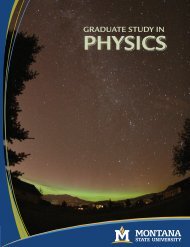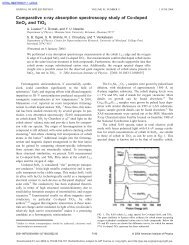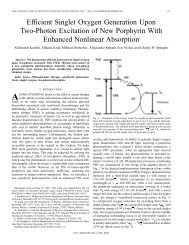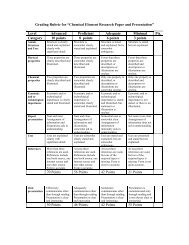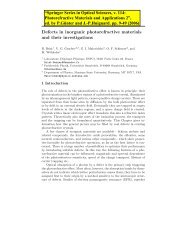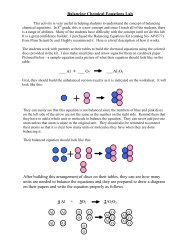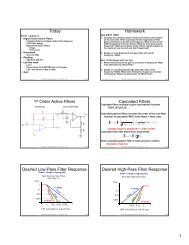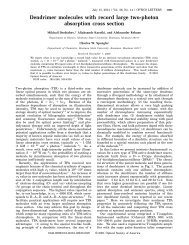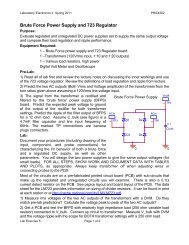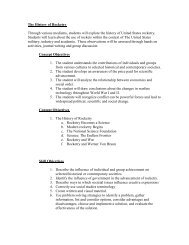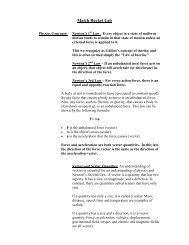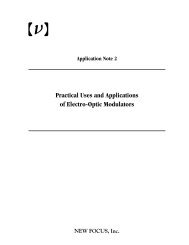Journal of Luminescence 107 (2004) - Department of Physics ...
Journal of Luminescence 107 (2004) - Department of Physics ...
Journal of Luminescence 107 (2004) - Department of Physics ...
You also want an ePaper? Increase the reach of your titles
YUMPU automatically turns print PDFs into web optimized ePapers that Google loves.
ARTICLE IN PRESS<br />
M. Drobizhev et al. / <strong>Journal</strong> <strong>of</strong> <strong>Luminescence</strong> <strong>107</strong> (<strong>2004</strong>) 194–202 201<br />
Phase shift, ∆ϕ (rad) Modulation amplitude, M<br />
0.2<br />
0.1<br />
(a)<br />
4<br />
3<br />
2<br />
1<br />
20 40 60 80 100 120<br />
Modulation amplitude, M<br />
(a)<br />
Phase shift, ∆ϕ (rad)<br />
0.2<br />
0.1<br />
2<br />
1.5<br />
1<br />
0.5<br />
20 40 60 80 100 120<br />
(b)<br />
20 40 60 80 100 120<br />
T, K<br />
Fig. 8. Temperature dependence <strong>of</strong> the amplitude M (a) and<br />
phase shift Dj (b) <strong>of</strong> spectral grating observed in SiNc:PVB and<br />
corresponding fits <strong>of</strong> these data to Eq. (8) and (16) in nonmirror-symmetrical<br />
model.<br />
phonon frequency n m ¼ 39 cm 1 seems to be<br />
overestimated.<br />
Our next attempt was to simulate the data with<br />
asymmetrical model with four independent parameters<br />
(Figs. 8a and b). One-photon parameters<br />
were fixed to the values, known from hole-burning<br />
spectroscopy: a 1 ð0Þ ¼0:9andn 1 ¼ 17 cm 1 , and x 2<br />
and n 2 were varied. The best fitting values obtained<br />
for these parameters are x 2 ¼ 1:0(a 2 ð0Þ ¼0:37) and<br />
n 2 ¼ 56 cm 1 . It is obvious that this fit fails again<br />
in describing the phase shift <strong>of</strong> Fig. 8b.<br />
We could obtain a reasonablygood fit (Figs. 9a<br />
and b) onlyif we artificiallyset a 2 ðTÞ ¼0ðx 2 ¼<br />
10 000Þ and let other three parameters vary<br />
independently. This implies no ZPL in TPA<br />
spectrum even at the lowest temperature. For the<br />
emission spectrum we obtain reasonable x 1 ¼ 0:46<br />
and n 1 ¼ 27 cm 1 , while the Debye–Waller factor<br />
again occurs smaller than measured in Ref. [14]<br />
(0.63 vs 1.0). Note that the homogeneous TPA<br />
spectrum turns out to be stronglyasymmetric with<br />
(b)<br />
20 40 60 80 100 120<br />
T, K<br />
Fig. 9. Temperature dependence <strong>of</strong> the amplitude M (a) and<br />
phase shift Dj (b) <strong>of</strong> spectral grating observed in SiNc:PVB and<br />
corresponding fits <strong>of</strong> these data to Eq. (8) and (16) in nonmirror-symmetrical<br />
model, where the Debye–Waller factor for<br />
TPA (a 2 ) was set to zero.<br />
respect to homogeneous one-photon emission<br />
spectrum. Not onlydoes this absorption contain<br />
no ZPL (a 2 ð0Þ ¼0), but its PW is shifted byonly<br />
n 2 ¼ 10 cm 1 from the zero-phonon origin.<br />
Several important conclusions can be drawn<br />
from these observations. First <strong>of</strong> all, mirrorsymmetric<br />
spectral model works well for Chl. This<br />
is not verysurprising result because this molecule<br />
does not possesses the center <strong>of</strong> inversion, and,<br />
therefore, selection rules for one- and two-photon<br />
transitions should be the same. On the other hand,<br />
TPA gratings in SiNc:PVB system are best<br />
described bystronglyasymmetrical model in<br />
which ZPL <strong>of</strong> TPA is completelymissing. This<br />
fact can be explained if we consider selection rules<br />
for pure electronic transition in this centrosymmetrical<br />
molecule. Since we are dealing with<br />
gerade2ungerade; S 0 2S 1 one-photon transition,<br />
it must be stronglyforbidden for pure electronic



